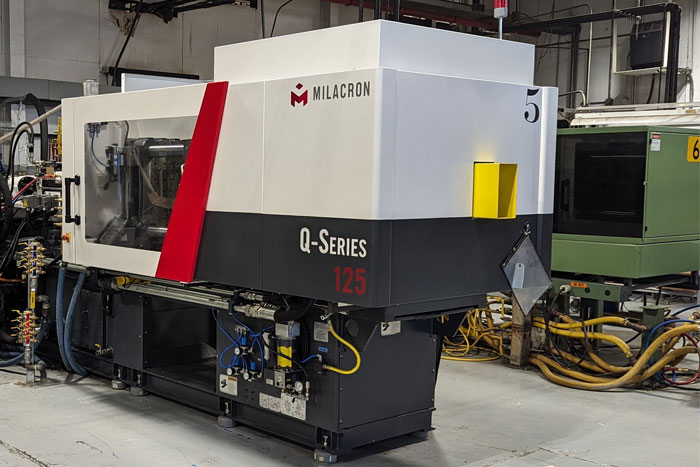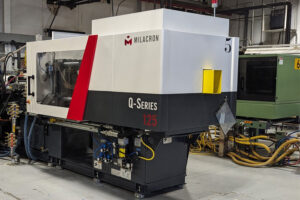
Injection molding is one of the most popular and cost-effective manufacturing methods to create large volumes of parts. Injection molding can create high-quality parts in a variety of materials. However, poor design choices in a part’s design can often result in unnecessary tooling costs and lead times. By considering the following best practices when designing products for injection molding, you can help reduce costs and enhance part quality.
What is injection molding?
Injection molding is a manufacturing process where a highly specialized machine injects molten plastic into a mold under high temperature and pressure to form a plastic part. The molten plastic is allowed to cool and solidify before the mold halves retract, and ejector pins release the part from the mold. Injection molding is well suited to high-volume production because it quickly produces reliable parts. Tooling costs for molds can often be high, but injection molded parts offset this by being extremely cheap on a per-part basis compared to other manufacturing methods.
Designing for injection molding
When designing parts for injection molding, it’s essential to optimize your design for manufacturability to achieve cost-effective and high-quality production. Key factors to consider include:
Design thickness
One of the most important considerations when designing for injection molding is uniform part thickness. Making the part a uniform thickness allows for uniform cooling, which helps prevent warping, sinks, or part distortion. All injection molded parts shrink slightly as they cool, so uniform thickness helps ensure that the part stays proportional and does not warp. If areas of the part are too thick, consider coring out sections or using the thickness analysis tool in your CAD software to help ensure a uniform thickness. Thicker parts tend to be stiffer and stronger but take longer to cool, which can extend cycle times.
Draft Angle
A draft angle is a taper or slope applied to the vertical faces of a plastic part to help it eject from its mold. Without proper draft angles, your part is likelier to stick to the mold and either warp or break when removed. Generally, when designing parts for injection molding, you should draft all surfaces parallel to the direction of steel separation. Additionally, always direct your drafts away from the mold’s parting line to ensure the parts are released from the mold easily. Mold finish, resin choice, and part geometry all affect the degree of draft needed. The industry standard is at least one degree of draft for all injection molded parts. However, an additional degree may be necessary if the parts have added texture.
Corners and radii
Ribs
Bosses
Undercuts
Mechanical Strength
Mechanical strength and structure are other important considerations when designing injection molded parts. Plastics have different mechanical properties from steel parts because plastics have nonlinear mechanical behavior. Plastics are viscoelastic materials prone to creep and stress relaxation over time. Creep is deformation that occurs slowly over time with the same load. Stress relaxation is a phenomenon that causes a decrease in internal stress over time. Stress relaxation can be a problem for features such as snap fits or other fasteners if they rely on tension. Temperature can also have a dramatic effect on the mechanical properties of plastics.
There are several ways to increase the strength and stiffness of an injection molded part. Increasing the part thickness is often the simplest way to accomplish this, as stiffness scales with thickness cubed; however, this can increase the material cost and change important dimensions of the part. Adding curvature or corrugations to a part is another easy way to increase stiffness. Different plastics also have various levels of strength, so choosing a tougher resin can increase a part’s strength. Resins can also be compounded with glass fiber, rubber, or ceramic to create a stronger or more impact-resistant material. Be sure to add radii to perpendicular sections of the part to reduce stress concentrations. Even a small radius can drastically reduce the amount of stress a part experiences, reducing the risk of the part snapping. Always consider the loads and environmental conditions that your part will need to withstand as you create an injection-molded design.
In conclusion, designing for injection molding requires a careful balance of considerations to ensure both the manufacturability and functionality of your part. By adhering to best practices—such as maintaining uniform thickness, incorporating appropriate draft angles, and optimizing features like ribs, bosses, and corners—you can avoid common pitfalls that lead to increased costs and production delays. Thoughtful product design choices from the outset not only streamline the injection molding process but also contribute to the creation of high-quality, durable parts that meet your specific needs. Ultimately, understanding and applying these principles can make the difference between a successful product and one fraught with manufacturing challenges.
Get a Free Quote
About Synectic Product Development: Synectic Product Development is an ISO 13485 certified, full-scale product development company. Vertically integrated within the Mack Group, our capabilities allow us to take your design from concept to production. With over 40 years of experience in design, development, and manufacturing, we strive for ingenuity, cost-effectiveness, and aesthetics in our designs. Learn more about our product development services and see how we can help your next project.


